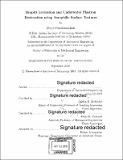Droplet levitation and underwater plastron restoration using aerophilic surface textures
Author(s)
Panchanathan, Divya
DownloadFull printable version (21.64Mb)
Other Contributors
Massachusetts Institute of Technology. Department of Mechanical Engineering.
Advisor
Gareth H. McKinley and Kripa K. Varanasi.
Terms of use
Metadata
Show full item recordAbstract
This thesis explores the use of active components in liquids and responsive surfaces to resist the wetting of water on solid surface textures. When a superhydrophobic surface comes into contact with water, it traps a thin layer of air (plastron) within its surface texture. This entrapped air is advantageous for reducing the contact line pinning of water droplets on the surface and lowering the skin friction drag experienced by the surface underwater. However, these aerophilic textures are prone to impregnation by water due to turbulent pressure fluctuations from external flows and dissolution of the trapped gas into the water. It is therefore desirable to develop strategies to restore the plastron underwater. A common method used to reduce the contact line pinning of water droplets on surfaces is the Leidenfrost effect, wherein the droplets are levitated on a cushion of vapor over the surface. But this typically requires the substrate to withstand high temperatures and also results in the loss of the droplet volume due to thermal evaporation. In this work, we explore new methodologies for locally generating gas near superhydrophobic surfaces to achieve room temperature droplet levitation and recover submerged superhydrophobic surfaces from wetting failure. In the first part of this thesis, we explore a novel chemical method to replenish the plastron in situ on superhydrophobic textures which have undergone a Cassie-to-Wenzel transition underwater. We use the decomposition reaction of hydrogen peroxide on superhydrophobic surfaces prepared with a catalytic coating to generate oxygen gas for plastron recovery. We also provide a thermodynamic framework for designing superhydrophobic surfaces with optimal texture and chemistry for underwater plastron regeneration. We finally demonstrate the practical utility of this method by fabricating periodic microtextures on aluminum surfaces that incorporate a cheap catalyst, manganese dioxide. We perform drag reduction experiments under turbulent flow conditions in a Taylor-Couette cell which show that more than half of the drag increase ensuing from plastron collapse can be recovered spontaneously using this method. In the second part of this thesis, we demonstrate room-temperature Leidenfrost effect by using carbonated water droplets on superhydrophobic surfaces. We observe the levitation-to-wetting transition of these degassing droplets using light interferometry on transparent superhydrophobic substrates. We characterize the timescales of wetting transitions with respect to the concentration of dissolved carbon dioxide, and show that a critical dissolved CO₂ concentration of at least 10 mM is required for achieving droplet levitation. We also derive a model based on lubrication theory combined with a lumped capacitance approach to predict the levitation time of degassing droplets. We finally display the practical utility of this phenomena for reducing friction between droplets and surfaces, droplet sorting, droplet self-propulsion, and triggering on-demand droplet levitation using chemical reactions.
Description
Thesis: Ph. D., Massachusetts Institute of Technology, Department of Mechanical Engineering, 2018. Cataloged from PDF version of thesis. Includes bibliographical references (pages 155-167).
Date issued
2018Department
Massachusetts Institute of Technology. Department of Mechanical EngineeringPublisher
Massachusetts Institute of Technology
Keywords
Mechanical Engineering.